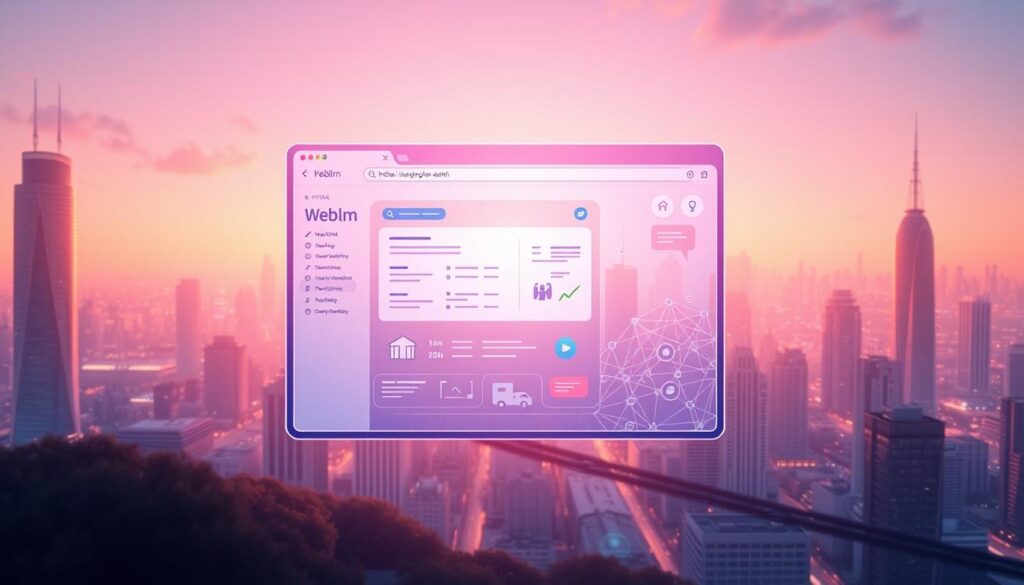
We’re excited to introduce WebLLM, a technology that can change how we use the web. WebLLM is a set of technologies that make web interactions faster and more natural. It’s all about making our online interactions better.
Exploring WebLLM, we’ll see how it can improve our online experience. It’s all about making the web more user-friendly and efficient. With this in mind, we can see how it will change different industries and uses.
Introduction to WebLLM
We’ll give you a detailed look at WebLLM, including its main parts and features. Knowing what WebLLM is and what it does opens up new possibilities for web development. It’s a chance to make the web more interactive and useful.
Key Takeaways
- WebLLM is a powerful technology that can revolutionize web interactions
- The WebLLM definition refers to a set of technologies that enable real-time processing and natural language understanding
- Understanding what is WebLLM is crucial to unlocking its full potential
- WebLLM can enhance user experience and provide more efficient web interactions
- The WebLLM meaning is closely tied to its ability to transform the way we interact with the web
- WebLLM has the potential to impact various industries and applications
What is WebLLM: A Comprehensive Definition
Exploring WebLLM, it’s key to grasp the webllm explanation and webllm overview. WebLLM is a cutting-edge tech that changes how we use the web. It aims to make our online interactions smooth and easy.
Core Components of WebLLM
WebLLM’s heart includes natural language processing, machine learning, and data analytics. These elements combine to offer a detailed webllm overview. They help users navigate the web better and faster.
Key Features and Capabilities
WebLLM boasts several standout features and abilities:
- Real-time processing and analysis of user data
- Personalized recommendations and suggestions
- Intuitive user interface and experience
These features make WebLLM a vital tool for improving our web interactions.
The Evolution of WebLLM Technology
WebLLM technology has grown a lot over time. Advances in natural language processing and machine learning have been key. Now, WebLLM is a powerful tool that’s changing how we interact with the web, offering a full webllm explanation and overview.
The Technical Foundation of WebLLM
Exploring WebLLM’s technical side is key. It’s built on advanced tech that powers its abilities. We’ll look into WebLLM’s architecture and framework to understand its support for its features.
WebLLM’s foundation is made for a strong and growing web platform. It includes:
- Advanced algorithms for real-time processing
- Integration with existing web systems
- Support for natural language understanding

Knowing WebLLM’s tech foundation helps us see its strengths and uses. Next, we’ll see how WebLLM changes web interactions and opens new doors for users.
How WebLLM Transforms Web Interactions
We’re excited to dive into how WebLLM changes web interactions. It makes them easier and more fun. With real-time processing, WebLLM answers questions right away. This makes the web experience better. If you’re searching for a webllm guide, knowing this is key.
WebLLM’s core strength is understanding natural language. This lets users talk to web apps like they’re chatting with friends. For developers looking for webllm information, this tech boosts user interaction.

- Enhanced user experience through real-time interactions
- Improved accessibility with natural language understanding
- Simplified integration with existing web systems for developers
Developers can make web apps more interactive with WebLLM. This leads to happier users and more engagement. Whether you need a full webllm guide or just some webllm information, knowing how WebLLM works is the first step.
WebLLM Architecture and Framework
We will give you a detailed look at the WebLLM architecture and framework. It includes its parts and how they work together for online legal research. This framework is great for web interactions that need complex data processing and analysis.
The WebLLM architecture has several important parts, including:
- Data ingestion and processing
- Machine learning and natural language processing
- Knowledge graph and database management
These parts work together to help WebLLM. They make it possible for WebLLM to change how we interact with the web, mainly in online legal research.

Knowing about the WebLLM architecture and framework helps developers. They can create effective solutions that use WebLLM for online legal research and more. We will keep looking into WebLLM’s capabilities and uses in the next sections.
Implementing WebLLM in Your Projects
Using WebLLM in your projects can be a game-changer. The right law library resources are key. Understanding how to set it up, install it, and configure it is crucial. This knowledge boosts performance and effectiveness.
Here are some important things to remember:
- Setup requirements: Make sure you have the right infrastructure and resources for WebLLM.
- Installation process: Follow a detailed guide for a smooth installation.
- Configuration best practices: Optimize your setup to get the best out of WebLLM.
By following these tips and using the right law library resources, you can unlock WebLLM’s full potential. This will take your projects to new heights.

Remember, proper setup is key to WebLLM success. Spend time learning about setup, installation, and configuration. This will prepare you for success and maximize the benefits of this powerful tool.
Security Features and Privacy Considerations
We take the security and privacy of our users’ data very seriously. This is true, even more so when it comes to digital legal databases. Our system is built to keep all data safe and sound.
We have many security features to keep your data safe. These include access control, data encryption, and regular security checks. These steps help keep your data from falling into the wrong hands.
We also value transparency and accountability in how we handle data. We think you should know how your data is used and protected. So, we make sure to give you clear and simple information about our data handling.

Our dedication to security and privacy shows in our compliance with laws and standards. We keep our security policies up to date. This ensures they stay effective and follow the best practices.
When you use our system, you can be sure your data is in good hands. We work hard to protect your digital legal databases and other sensitive information.
WebLLM Performance Optimization
As we work on WebLLM, improving its performance is key. We need it to handle lots of traffic and data well. This is vital for legal tech apps, where speed matters a lot. We can boost performance with caching and load balancing.
Using caching can make data access quicker. It stores often-used data in memory. Load balancing spreads traffic across servers, preventing any one server from getting too busy.

Other ways to improve WebLLM include managing resources like CPU and memory. This ensures the system can handle the workload. With these steps, WebLLM will be fast and efficient, perfect for legal tech apps.
- Caching strategies to reduce data retrieval time
- Load balancing techniques to distribute traffic across multiple servers
- Resource management to allocate system resources efficiently
Common Use Cases for WebLLM
We’ve looked at what WebLLM can do and its features. Now, let’s talk about how it’s used in different fields. WebLLM is great for the legal, document management, and contract analysis sectors. In law, legal research tools are key for lawyers and researchers to quickly find and understand important info.
Here are some ways WebLLM is used:
- Legal research: It helps analyze lots of legal data, showing insights and patterns that manual research might miss.
- Document management: WebLLM organizes and sorts documents, making it simpler to find and get specific info.
- Contract analysis: It analyzes contracts, spotting important terms and conditions, and suggesting ways to negotiate or change them.
These examples show how WebLLM can change many industries and uses. By using legal research tools and other WebLLM features, companies can work better, make more accurate decisions, and be more efficient.

WebLLM in Legal Research Applications
We are looking into how WebLLM boosts legal research. It makes managing legal info more efficient and effective. A virtual law library is key, offering a wide range of legal resources and databases.
Some important features of WebLLM in legal research include:
- Digital legal database integration, allowing for seamless access to relevant laws and regulations
- Case law analysis features, enabling researchers to analyze and compare relevant cases
- Regulatory compliance tools, helping to ensure that legal research is conducted in accordance with relevant regulations
With these features, WebLLM aids legal researchers in their work. It gives them access to a 
Customizing WebLLM for Specific Needs
Every industry and application has its own needs. That’s why customizing WebLLM is key to getting the most out of it. In the world of legal information technology, making WebLLM fit your needs can really help. It lets users use WebLLM to its fullest and make their work easier.
When customizing WebLLM, think about what you need. You can adjust settings like natural language processing and connect it with other systems. You can also use legal information technology to create special tools and apps for your needs. This might mean working with developers to solve specific problems.

To really use WebLLM well, look into all the ways you can customize it. This could mean:
* Changing settings to make it work better
* Connecting it with other tools and systems
* Making your own apps and tools
By customizing WebLLM, you can make it work better for you. This is true for legal information technology and other fields too. Customizing is the way to get the best out of WebLLM.
Troubleshooting WebLLM Issues
Working with WebLLM means knowing how to fix problems that come up. A good webllm explanation helps spot issues and find fixes. We’ll cover common problems, how to solve them, and keeping an eye on performance.
A webllm overview helps find where issues might happen. Some common problems include:
- Integration issues with other systems
- Slow performance from too much traffic or heavy tasks
- Security risks that could harm data
To solve these problems, we use strategies like:
- Keeping the system up to date with the latest patches
- Improving how resources are used and balancing the load
- Using strong security, like encryption and access controls
By using these strategies and knowing WebLLM well, we can make sure users have a smooth experience. It’s also key to keep an eye on how well WebLLM is working. This way, we can catch and fix problems early.
Integration with External APIs
Integrating WebLLM with external APIs is key to expanding its use. As we explore the webllm guide, we see many ways to do this. There’s a lot of webllm information out there, and we’ll cover it all.
To link WebLLM with external APIs, just follow these steps:
- Choose the API you want to integrate with
- Configure the API settings according to the webllm guide
- Use integration tools to connect WebLLM with the external API
By doing these steps, we can make WebLLM work better with other APIs. This adds more value for users. For more details, check out the webllm information online.
In short, linking WebLLM with external APIs is easy with the right tools and settings. By using the webllm guide and looking at webllm information, we can make WebLLM more useful for everyone.
WebLLM Best Practices and Guidelines
As we work on WebLLM, it’s key to set up best practices and guidelines. This ensures it works well and is effective. In online legal research, WebLLM helps us find what we need faster.
We should aim for a strong and growing system. This means designing a flexible data model and implementing efficient algorithms. These help handle lots of data and user requests.
Development Standards for WebLLM
- Design a flexible data model to accommodate different types of legal data
- Implement efficient algorithms for searching and retrieving information
- Use secure protocols for data transmission and storage
Testing Protocols for WebLLM
To make sure WebLLM is top-notch, we need strict testing. This covers its functionality, performance, and security. We do thorough unit testing and integration testing to find and fix problems.
Maintenance Procedures for WebLLM
Keeping WebLLM in good shape is vital. This includes monitoring system logs and performing routine updates. By following these steps, WebLLM will keep helping with online legal research and law library resources.
Scaling WebLLM Applications
As we work on WebLLM applications, scaling them is key. We need to make sure they can handle more traffic and data. Using digital legal databases helps a lot in storing and managing data.
A legal technology platform can also help scale WebLLM. It offers many tools and features for growth. Important steps for scaling include:
- Configuring the app to handle more traffic and data
- Using scaling tools for high demand
- Connecting with external APIs for more features
By following these steps and using the right tools, we can scale WebLLM. This ensures a strong and reliable experience for users.
Future Developments and Updates
We’re excited to see what’s next for WebLLM, a game-changer in web interaction. Looking ahead, we’ll see big leaps in legal research tools and advanced virtual law library systems.
Some key areas to watch include:
- Enhanced natural language processing capabilities
- Improved integration with existing web systems
- Expanded use cases for WebLLM in various industries
These updates will change how we use legal research tools and virtual law library resources. We’ll see better research, data analysis, and decision-making.
Keeping up with WebLLM’s latest is crucial. This way, we can fully use its power to drive innovation and growth.
Conclusion
WebLLM is changing how we interact online. It offers real-time processing and natural language understanding. This makes WebLLM a game-changer for the digital world.
It has the power to make our online experiences better. It can also make workflows smoother and open up new possibilities. This is true for many different uses.
In this article, we’ve covered the basics of WebLLM. We’ve talked about its technical side and how to use it. Now, you know how to use it in your projects.
Keep exploring and trying out WebLLM in your work. Watch for new trends and features that will come. Using WebLLM can make your web projects more efficient and innovative.



Leave a Reply